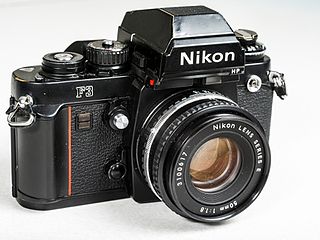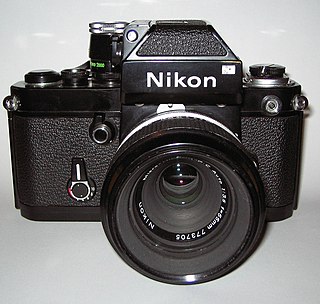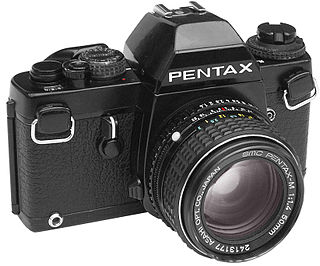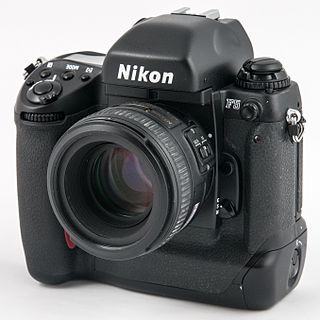
A single-lens reflex camera (SLR) is a camera that typically uses a mirror and prism system that permits the photographer to view through the lens and see exactly what will be captured. With twin lens reflex and rangefinder cameras, the viewed image could be significantly different from the final image. When the shutter button is pressed on most SLRs, the mirror flips out of the light path, allowing light to pass through to the light receptor and the image to be captured.

The Nikon FM is a mechanically operated, interchangeable lens, 35 mm film, single-lens reflex (SLR) camera. It was manufactured in Japan between 1977 and 1982 by Nippon Kogaku K. K..

The Nikon FM3ᴀ is an interchangeable-lens, focal-plane shutter, 35 mm film, single-lens reflex (SLR) camera. It was manufactured by Nikon Corporation in Japan, on small-volume assembly lines, from 2001 to 2006. The camera was available in two colours: all black and satin chrome. The introductory US list price for the chrome body only was $820.

The Nikon F6 is a 35 mm film single-lens reflex camera body manufactured by Nikon between 2004 and 2020. It was the sixth film camera in Nikon's 35mm F-series SLR line-up. Designed by Nikon, the model was manufactured at their Sendai plant.

The Nikon F-801 is a 35mm SLR released worldwide in June 1988 and manufactured until 1991, when it was replaced by the improved Nikon F-801s, which in turn was discontinued in early 1995. Although its autofocus mechanism is slow in comparison to modern standards, it was an improvement on Nikon's first attempt at an autofocus SLR - the F-501, and proved to be reliable and durable, typical of Nikon's cameras.

The Nikon FM2 is an advanced semi-professional, interchangeable lens, 35 mm film, single-lens reflex (SLR) camera. It was manufactured by Nippon Kogaku K. K. in Japan from 1982 to 2001. The original camera was released with some incremental improvements in 1984, and this later version is commonly referred to as the FM2ɴ, although both versions are labelled as the FM2 on the front of the camera body.

The Nikon FE is an advanced semi-professional level, interchangeable lens, 35 mm film, single-lens reflex (SLR) camera. It was manufactured by Nikon in Japan from 1978 to 1983, and was available new from dealer stock until c. 1984. The FE uses a metal-bladed, vertical-travel focal plane shutter with a speed range of 8 to 1/1000 second, plus Bulb, and flash X-sync of 1/125th second. It had dimensions of 89.5 millimetres (3.52 in) height, 142 mm (5.6 in) width, 57.5 mm (2.26 in) depth and 590 grams (21 oz) weight. It was available in two colors: black with chrome trim and all black. As on the FM, its model designation did not appear on the front of the camera, but was engraved as a small "FE" preceding the serial number on the rear of the housing.

The Nikon F3 was Nikon's third professional single-lens reflex camera body, preceded by the F and F2. Introduced in March 1980, it had manual and semi-automatic exposure control whereby the camera would select the correct shutter speed. The Nikon F3 series cameras had the most model variations of any Nikon F camera. It was also the first of numerous Nikon F-series cameras to be styled by Italian designer Giorgetto Giugiaro, and to include a red stripe on the handgrip – a feature that would later become a signature feature of many Nikon cameras.

The Nikon FG is an interchangeable lens, 35 mm film, single-lens reflex (SLR) camera. It was manufactured by Nippon Kogaku K. K. in Japan from 1982 to 1986.

The Nikon F-501 was the first successful autofocus SLR camera sold by the Nikon Corporation beginning in 1986. A nearly identical, albeit manual focus version, called the Nikon F-301 was also available. Subsequent models in the consumer line included the Nikon F-401, Nikon F-601, and Nikon F-801 / F-801s.
The Olympus OM System was a line of 35mm single-lens reflex cameras, lenses and accessories sold by Olympus between 1972 and 2002. The system was introduced by Olympus in 1972. The range was designed by Yoshihisa Maitani, chief designer for Olympus, and his staff; OM stands for Olympus Maitani.

The Nikon F2 is a professional-level, interchangeable lens, 35 mm film, single-lens reflex (SLR) camera. It was manufactured by the Japanese optics company Nippon Kogaku K. K. in Japan from September 1971 to 1980. It used a horizontal-travel focal plane shutter with titanium shutter curtains and a speed range of 1 to 1/2000 second plus Bulb and Time, and flash X-sync of 1/80 second. It had dimensions of 98 mm height, 152.5 mm width, 65 mm depth and 730 g weight. It was available in two colors: black with chrome trim and all black. The F2 was adopted by both casual photographers and professional photographers, the latter of those especially photojournalists covering the later half of the Vietnam War.

Nikkormat was a brand of cameras produced by the Japanese optics company Nippon Kogaku K. K., as a consumer version of the professional Nikon brand. Nikkormat cameras, produced from 1965 until 1978, were simpler and more affordable than Nikon-branded cameras, but accepted the same lenses as the Nikon F series cameras.

The Pentax LX is a 35mm single-lens reflex camera produced by Pentax in Japan. It was introduced in 1980 to commemorate the 60th anniversary of Asahi Optical Co., and was produced until 2001. It is the top-of-the-line professional, or "system", camera in the Pentax manual focus range, with manual and aperture priority automatic exposure modes and an advanced light metering system. The LX uses the K mount, which is the Pentax proprietary bayonet lens mount, and has a large body of accessories. The camera has several unique or uncommon features, and compared with contemporary professional camera bodies from rival manufacturers, like the Canon New F-1 or Nikon F3, the LX body is smaller and lighter, weighing in at 570 grams with its standard FA-1 finder.

The Nikon F5 is a professional 35 mm film-based single-lens reflex camera body manufactured by Nikon from 1996 through 2004. It was the fifth in Nikon's professional film camera line, which began in 1959 with the Nikon F. It followed the Nikon F4 of 1988, which introduced in-body autofocus to Nikon's professional line. The F5 was in turn succeeded by the Nikon F6, as well as Nikon's parallel range of professional digital SLRs, beginning with the Nikon D1.

The EOS-1N is a 35mm single lens reflex (SLR) camera body produced by Canon. It was announced by Canon in 1994, and was the professional model in the range, superseding the original Canon EOS-1. The camera was itself superseded by the EOS-1V in 2000.

The Nikon F90 is a 35mm SLR camera manufactured between 1992 and 2001 and replaced the earlier Nikon F-801. At the time of its release it was noted for its fast autofocus speed compared to previous Nikon models, which had lagged behind competitor Canon's. It was thus seen by many as a 'stop-gap' measure to prevent the mass migration of many Nikon-using professional photographers to Canon, as Nikon's next fully professional camera, the F5, was some time away from release. The Nikon F4, the professional model available at the time of the F90's release, had very slow autofocus compared to Canon's autofocus SLRs.

The Minolta A-mount camera system was a line of photographic equipment from Minolta introduced in 1985 with the world's first integrated autofocus system in the camera body with interchangeable lenses. The system used a lens mount called A-mount, with a flange focal distance 44.50 mm, one millimeter longer, 43.5 mm, than the previous SR mount from 1958. The new mount was wider, 49.7 mm vs. 44.97 mm, than the older SR-mount and due to the longer flange focal distance, old manual lenses were incompatible with the new system. Minolta bought the autofocus technology of Leica Correfot camera which was partly used on the a-mount autofocus technology. The mount is now used by Sony, who bought the SLR camera division from Konica Minolta, Konica and Minolta having merged a few years before.

The Pentax ME F was an amateur level, interchangeable lens, 35 mm film, single-lens reflex (SLR) camera. It was manufactured by Asahi Optical Co., Ltd. of Japan from November 1981 to 1984. The ME F was a heavily modified version of the Pentax ME-Super, and a member of the Pentax M-series family of SLRs. It was the first mass-produced SLR camera to come with an autofocus system.

The Minolta 9000 AF is a professional Single-lens reflex autofocus camera, introduced by Minolta in August 1985. It was both Minolta's and the world's first professional autofocus SLR. It was called Minolta Maxxum 9000 in the US and Minolta α-9000 in Japan.





















